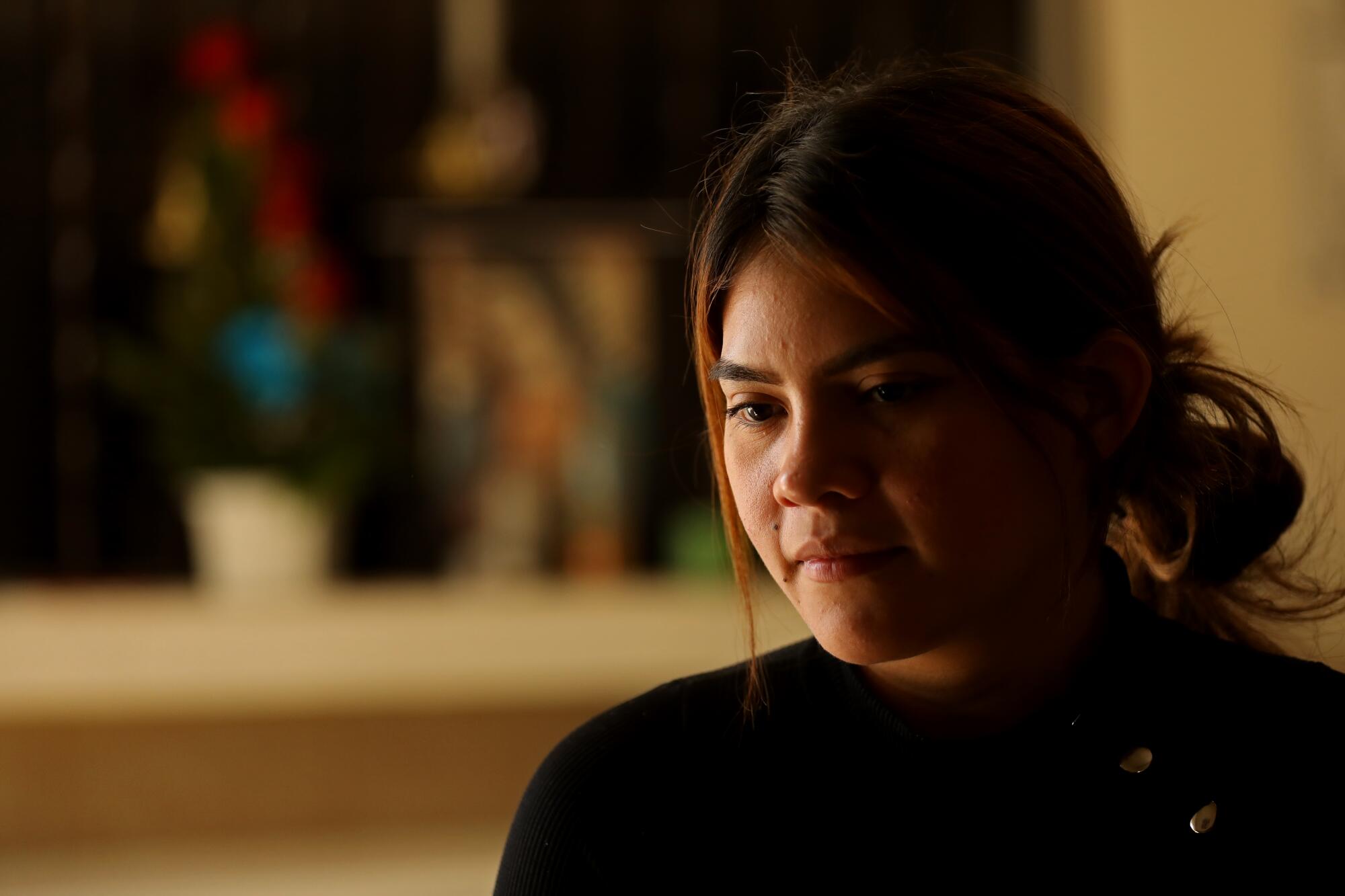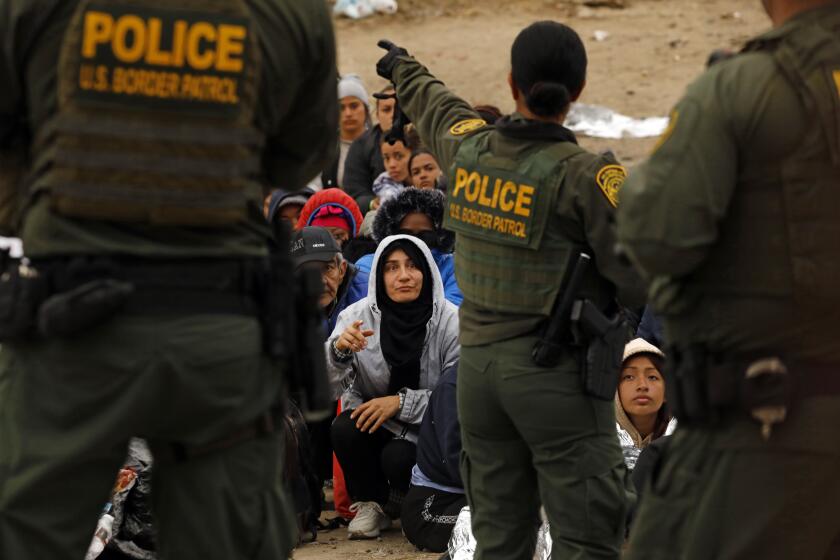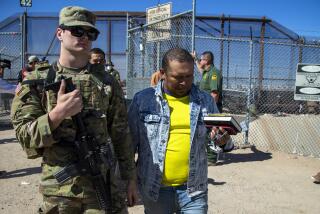
After 5½ months living in a shelter across the border from Yuma, Ariz., Soraya Amaya started feeling desperate.
The 22-year-old from El Salvador had applied daily for asylum appointments for her family of five using CBP One, the U.S. Customs and Border Protection mobile app that launched in January and that migrants must now use to seek humanitarian protection.
Each day she had been met with a denial — since its launch, the application has been plagued by technical glitches and a scarcity of appointments that have shut out many migrants.
But finally, on Thursday, her husband’s stepfather called with good news.
“We’re leaving,” he told her. “We got it.”
Amaya’s experience remains the exception to the rule. Just 1,000 appointments are granted daily through the app, but some migrants say they’ve recently noticed fewer glitches and more appointments being granted to those who have been waiting the longest, part of an update the Department of Homeland Security had promised. The app was intended to reduce the number of crossings between ports of entry.
The expiration of Title 42, a policy implemented amid the COVID-19 pandemic that prevented many asylum seekers from entering the U.S., has presented a dilemma for tens of thousands of U.S.-bound migrants stranded in Mexico. While there was generally no consequence for being expelled multiple times under Title 42, being deported now can have life-altering ramifications, including being banned for years from reentering the United States.
Before the CBP One app’s release, Amaya and her family attempted to enter the U.S. once, presenting themselves to border agents — who detained them for a few days and then returned them to Mexico.
But Title 42 was still in effect then, blocking migrants from requesting asylum. During the experience, she said, a Border Patrol agent threw her family’s documents to the ground and stomped on them.

When she and her family were released, a Mexican humanitarian organization drove them to Casa del Migrante, a shelter in San Luis Rio Colorado, Mexico, that distributes 200 meals daily.
Most migrants are able to stay there a maximum of three days. Amaya’s family worked out a deal in which she managed some of the shelter’s day-to-day activities in exchange for an unlimited stay.
She became the right hand of the director, Martin Salgado Ames. Her husband, meanwhile, found work on a local ranch. They were housed and fed, but their lives were still in limbo.
Back in El Salvador, Amaya and her husband had a thriving business selling curtido, a popular cabbage slaw.
“I can’t afford to make a mistake.”
— Juan Manuel Torres León, 40-year-old chef from Venezuela
Then came the gang threats.
First it was extortion: They were forced to pay $35 a month, then $60 and $100. Unable to afford the payments and their bills, Amaya and her husband decided to tell the police. The effort was futile: After extortion came death threats, she said.
They fled last year with their young son and her husband’s parents, and $105 in their pockets. In Chiapas, Mexico, they were helped by a church. They obtained humanitarian visas in Mexico and applied for asylum there.
Feeling safer, Amaya and her 4-year-old son were on their way to a playground one day when two men in a white truck attempted to kidnap them, she said. Local residents helped them escape, but the incident left her wondering whether the gang had caught up to her. After all, they’d seen its graffiti all over town.
Once more, they fled.
At Casa del Migrante, Amaya spent time over the months she was there helping other migrants register for appointments. A few people got lucky, mostly single adults or single mothers with one child.
She started thinking, “Why, God, why are we still here?”
Amaya and her family are scheduled for appointments in the U.S. later this month. The wait, she said, was worth it. But it’s bittersweet: Now it’s the other women at the shelter, all of them Mexican or Central American, who are wondering when they’ll get their turn.
The end of Title 42 reopened the possibility for migrants from El Salvador, Guatemala, Honduras and Mexico, who made up most of the expulsions under the rule, to again apply for asylum in the U.S. But for someone from one of those countries, it is often difficult to actually receive it. Immigration judges have argued, for example, that gang violence doesn’t meet the standard for humanitarian protection.
At the shelter, decorated sparingly but for a shrine to the Virgin Mary, a sign in English offers words of hope: “With God, all things are possible.”
Title 42, the policy used to keep asylum seekers out of the U.S. during the pandemic, expired Thursday night, ushering in a new era for U.S. border control.
Meanwhile, in Ciudad Juarez, Mexico, Juan Manuel Torres León, a 40-year-old chef from Venezuela, also faced uncertainty about his odds of getting an appointment through the mobile app. The situation after Title 42 is “much more complicated,” he said.
“I can’t afford to make a mistake,” he added.
He and his wife were detained at the border in El Paso last week, he said. His wife was released, given a notice to appear in immigration court, and planned to fly from El Paso to Miami to reunite with relatives. But Torres says that after four days in Border Patrol custody, he was sent back to Juarez on Thursday night, the last few hours that Title 42 was in effect.
The couple left their two daughters, ages 7 and 5, back in Venezuela.
“The trip was too dangerous for them,” Torres said, speaking outside a church shelter.
Hours after the end of Title 42 immigration restrictions, U.S. officials said they hadn’t seen an influx of crossings at the border or any significant increase in migration.
He recalled the grueling trek through the Darien Gap jungle from Colombia into Panama — record numbers of migrants have been hiking through the treacherous strip — and the difficult slog from Central America to the U.S.-Mexico border.
Now Torres is stuck in Juarez, contemplating his next step. He and other Venezuelans here have paid 50 pesos a night, about $2.50, to sleep on the floor of an abandoned building.
He hopes to score an interview with U.S. immigration authorities through the CBP One app, but as has been the case for so many others, the process has been frustrating. He said he had been trying for more than two months to get an appointment.
“The whole thing feels improvised, totally random,” he said. “A question of luck.”
Like many Venezuelans, he has no current passport — the document is expensive and difficult to obtain in that country — complicating efforts to apply for temporary lawful entry, which is available for some Venezuelans who have U.S. sponsors.
“If I try to cross and get detained again, I’m afraid I’ll never be able to be reunited with my wife,” Torres said. “I have to be very careful about my next step, now that Title 42 is over. Everything depends on making the correct decision now.”

At Cobina Posada del Migrante in Mexicali, Yusimy Vazquez, 53, lamented the changes to U.S. immigration policy. Had she known how difficult it would become to request asylum, she said, she wouldn’t have risked leaving Cuba last Christmas Eve with her 6-year-old grandson.
Cubans, like Venezuelans, Nicaraguans and Haitians, can apply for humanitarian parole so long as they don’t attempt the journey by land or sea without authorization. U.S. Homeland Security officials will now inform some asylum seekers from those countries who have been arrested by Border Patrol that they can voluntarily return to Mexico in order to apply for the parole program from their home country.
For Vazquez, it’s too late — she’s already a mile from the California border. All she can do is hope she gets an appointment through the CBP One app to plead her case.
Vazquez said she received death threats after her daughter participated in 2021 protests against the government in Cuba. Her daughter fled to Mexico first, then crossed the Rio Grande and turned herself over to U.S. border agents. She now lives in Florida, and, due to immigration court backlogs, will plead her case for asylum in 2028.
Vazquez and her grandson have had a different experience. In Chiapas, a man kidnapped them, locking them in his parents’ home for nearly two weeks in an extortion attempt, she said. The kidnapper’s father eventually took pity on them and let them go, she said. But now her grandson suffers panic attacks.
Title 42, a public health policy invoked to control migration at the start of the COVID-19 pandemic, was lifted Thursday night.
The advocacy group Human Rights First has documented more than 13,400 violent attacks on asylum seekers stuck in Mexico during President Biden’s first two years in office.
Like other migrants, Vazquez chose to travel to Mexicali after learning through social media that the area had more humanitarian assistance and fewer people seeking U.S. entry than other border towns.
When she arrived late at night on April 19, two shelters turned her away before Cobina Posada del Migrante let her in. The shelter is also over capacity — it has space for 180, but 300 are staying there, said director Elizabeth Gallardo. On Saturday, Gallardo said 20 families — 60 people total — had landed CBP One appointments in the previous two days.
For Vazquez, that’s enough to stay hopeful.
“I have faith in God, primarily,” she said. “If today was your turn, congratulations. Tomorrow will be mine.”
Castillo reported from San Luis Rio Colorado and McDonnell from Ciudad Juarez.
More to Read
Get the L.A. Times Politics newsletter
Deeply reported insights into legislation, politics and policy from Sacramento, Washington and beyond. In your inbox three times per week.
You may occasionally receive promotional content from the Los Angeles Times.










